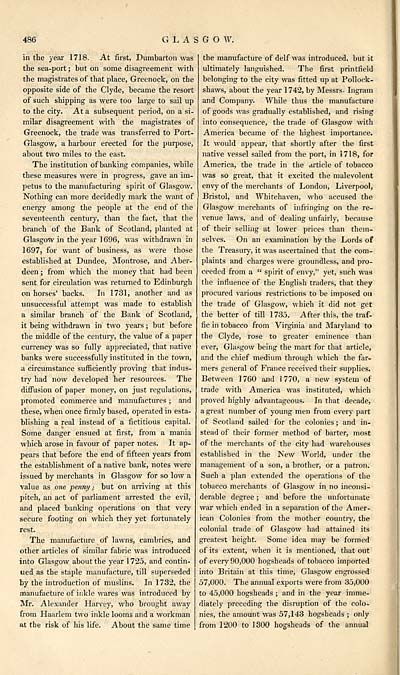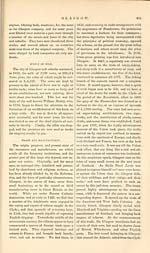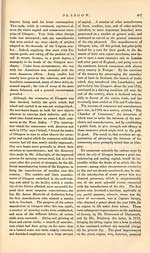Gazetteer of Scotland > Volume 1
(522) Page 486 - GLA
Download files
Complete book:
Individual page:
Thumbnail gallery: Grid view | List view

486
GLASGOW.
in the year 1718. At first, Dumbarton was
the sea-port ; but on some disagreement with
the magistrates of that place, Greenock, on the
opposite side of the Clyde, became the resort
of such shipping as were too large to sail up
to the city. At a subsequent period, on a si-
milar disagreement with the magistrates of
Greenock, the trade was transferred to Port-
Glasgow, a harbour erected for the purpose,
about two miles to the east.
The institution of banking companies, while
these measures were in progress, gave an im-
petus to the manufacturing spirit of Glasgow.
Nothing can more decidedly mark the want of
energy among the people at the end of the
seventeenth century, than the fact, that the
branch of the Bank of Scotland, planted at
Glasgow in the year 1696, was withdrawn in
1697, for want of business, as were those
established at Dundee, Montrose, and Aber-
deen ; from which the money that had been
sent for circulation was returned to Edinburgh
on horses' backs. In 1731, another and as
unsuccessful attempt was made to establish
a similar branch of the Bank of Scotland,
it being withdrawn in two years ; but before
the middle of the century, the value of a paper
currency was so fully appreciated, that native
banks were successfully instituted in the town,
a circumstance sufficiently proving that indus-
try had now developed her resources. The
diffusion of paper money, on just regulations,
promoted commerce and manufactures ; and
these, when once firmly based, operated in esta-
blishing a real instead of a fictitious capital.
Some danger ensued at first, from a mania
which arose in favour of paper notes. It ap-
pears that before the end of fifteen years from
the establishment of a native bank, notes were
issued by merchants in Glasgow for so low a
value as one penny ; but on arriving at this
pitch, an act of parliament arrested the evil,
and placed banking operations on that very
secure footing on which they yet fortunately
rest.
The manufacture of lawns, cambrics, and
other articles of similar fabric was introduced
into Glasgow about the year 1 725, and contin-
ued as the staple manufacture, till superseded
by the introduction of muslins. In 1732, the
manufacture of inkle wares was introduced by
Mr. Alexander Harvey, who brought away
from Haarlem two inkle looms and a workman
at the risk of his life. About the same time
the manufacture of delf was introduced, but it
ultimately languished. The first printfield
belonging to the city was fitted up at Pollock-
shaws, about the year 1742, by Messrs. Ingram
and Company. While thus the manufacture
of goods was gradually established, and rising
into consequence, the trade of Glasgow with
America became of the highest importance.
It would appear, that shortly after the first
native vessel sailed from the port, in 1718, for
America, the trade in the article of tobacco
was so great, that it excited the malevolent
envy of the merchants of London, Liverpool,
Bristol, and Whitehaven, who accused the
Glasgow merchants of infringing on the re-
venue laws, and of dealing unfairly, because
of their selling at lower prices than them-
selves. On an examination by the Lords of
the Treasury, it was ascertained that the com-
plaints and charges were groundless, and pro-
ceeded from a " spirit of envy," yet, such was
the influence of the English traders, that they
procured various restrictions to be imposed oa
the trade of Glasgow, which it did not get
the better of till 1735. After this, the traf-
fic in tobacco from Virginia and Maryland to
the Clyde, rose to greater eminence than
ever, Glasgow being the mart for that article,
and the chief medium through which the far-
mers general of France received their supplies.
Between 1760 and 1770, a new system of
trade with America was instituted, which
proved highly advantageous. In that decade,
a great number of young men from every part
of Scotland sailed for the colonies ; and in-
stead of their former method of barter, most
of the merchants of the city had warehouses
established in the New World, under the
management of a son, a brother, or a patron.
Such a plan extended the operations of the
tobacco merchants of Glasgow in no inconsi-
derable degree ; and before the unfortunate
war which ended in a separation of the Amer-
ican Colonies from the mother countiy, the
colonial trade of Glasgow had attained its
greatest height. Some idea may be formed
of its extent, when it is mentioned, that out
of every 90,000 hogsheads of tobacco imported
into Britain at this time, Glasgow engrossed
57,000. The annual exports were from 35,000
to 45,000 hogsheads ; and in the year imme-
diately preceding the disruption of the colo-
nies, the amount was 57,143 hogsheads ; only
from 1200 to 1300 hogsheads of the annual
GLASGOW.
in the year 1718. At first, Dumbarton was
the sea-port ; but on some disagreement with
the magistrates of that place, Greenock, on the
opposite side of the Clyde, became the resort
of such shipping as were too large to sail up
to the city. At a subsequent period, on a si-
milar disagreement with the magistrates of
Greenock, the trade was transferred to Port-
Glasgow, a harbour erected for the purpose,
about two miles to the east.
The institution of banking companies, while
these measures were in progress, gave an im-
petus to the manufacturing spirit of Glasgow.
Nothing can more decidedly mark the want of
energy among the people at the end of the
seventeenth century, than the fact, that the
branch of the Bank of Scotland, planted at
Glasgow in the year 1696, was withdrawn in
1697, for want of business, as were those
established at Dundee, Montrose, and Aber-
deen ; from which the money that had been
sent for circulation was returned to Edinburgh
on horses' backs. In 1731, another and as
unsuccessful attempt was made to establish
a similar branch of the Bank of Scotland,
it being withdrawn in two years ; but before
the middle of the century, the value of a paper
currency was so fully appreciated, that native
banks were successfully instituted in the town,
a circumstance sufficiently proving that indus-
try had now developed her resources. The
diffusion of paper money, on just regulations,
promoted commerce and manufactures ; and
these, when once firmly based, operated in esta-
blishing a real instead of a fictitious capital.
Some danger ensued at first, from a mania
which arose in favour of paper notes. It ap-
pears that before the end of fifteen years from
the establishment of a native bank, notes were
issued by merchants in Glasgow for so low a
value as one penny ; but on arriving at this
pitch, an act of parliament arrested the evil,
and placed banking operations on that very
secure footing on which they yet fortunately
rest.
The manufacture of lawns, cambrics, and
other articles of similar fabric was introduced
into Glasgow about the year 1 725, and contin-
ued as the staple manufacture, till superseded
by the introduction of muslins. In 1732, the
manufacture of inkle wares was introduced by
Mr. Alexander Harvey, who brought away
from Haarlem two inkle looms and a workman
at the risk of his life. About the same time
the manufacture of delf was introduced, but it
ultimately languished. The first printfield
belonging to the city was fitted up at Pollock-
shaws, about the year 1742, by Messrs. Ingram
and Company. While thus the manufacture
of goods was gradually established, and rising
into consequence, the trade of Glasgow with
America became of the highest importance.
It would appear, that shortly after the first
native vessel sailed from the port, in 1718, for
America, the trade in the article of tobacco
was so great, that it excited the malevolent
envy of the merchants of London, Liverpool,
Bristol, and Whitehaven, who accused the
Glasgow merchants of infringing on the re-
venue laws, and of dealing unfairly, because
of their selling at lower prices than them-
selves. On an examination by the Lords of
the Treasury, it was ascertained that the com-
plaints and charges were groundless, and pro-
ceeded from a " spirit of envy," yet, such was
the influence of the English traders, that they
procured various restrictions to be imposed oa
the trade of Glasgow, which it did not get
the better of till 1735. After this, the traf-
fic in tobacco from Virginia and Maryland to
the Clyde, rose to greater eminence than
ever, Glasgow being the mart for that article,
and the chief medium through which the far-
mers general of France received their supplies.
Between 1760 and 1770, a new system of
trade with America was instituted, which
proved highly advantageous. In that decade,
a great number of young men from every part
of Scotland sailed for the colonies ; and in-
stead of their former method of barter, most
of the merchants of the city had warehouses
established in the New World, under the
management of a son, a brother, or a patron.
Such a plan extended the operations of the
tobacco merchants of Glasgow in no inconsi-
derable degree ; and before the unfortunate
war which ended in a separation of the Amer-
ican Colonies from the mother countiy, the
colonial trade of Glasgow had attained its
greatest height. Some idea may be formed
of its extent, when it is mentioned, that out
of every 90,000 hogsheads of tobacco imported
into Britain at this time, Glasgow engrossed
57,000. The annual exports were from 35,000
to 45,000 hogsheads ; and in the year imme-
diately preceding the disruption of the colo-
nies, the amount was 57,143 hogsheads ; only
from 1200 to 1300 hogsheads of the annual
Set display mode to: Large image | Transcription
Images and transcriptions on this page, including medium image downloads, may be used under the Creative Commons Attribution 4.0 International Licence unless otherwise stated. ![]()
| Gazetteers of Scotland, 1803-1901 > Gazetteer of Scotland > Volume 1 > (522) Page 486 - GLA |
|---|
| Permanent URL | https://digital.nls.uk/97430626 |
|---|
| Description | Volume I: Abbey to Glenartney. |
|---|---|
| Attribution and copyright: |
|
| Description | By Robert Chambers and William Chambers. Glasgow: Blackie & Son, 1838. 2 volumes. |
|---|---|
| Shelfmark | NF.1461.g.7 |
| Additional NLS resources: | |

